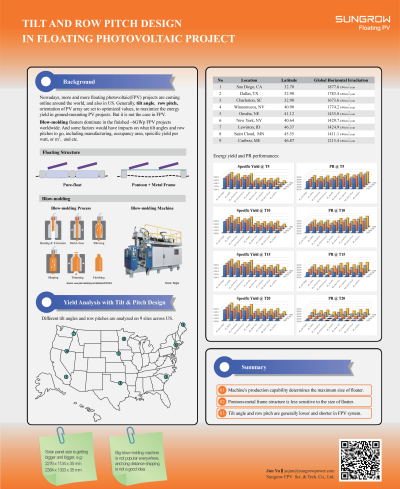Back

RE+ Tech
Tilt and row pitch design in US floating photovoltaic project
Tuesday, September 12, 2023
4:30 PM - 5:30 PM PDT
Location: Poster Area, Booth #11024, Level 1, Venetian Expo Hall


Jun Yu, n/a (he/him/his)
Product Manager
Sungrow FPV Sci. & Tech. Co., Ltd.
Hefei, Anhui, China (People's Republic)
Poster Presenter(s)
Background, Description, Delivery and Learning Objective: Nowadays, more and more floating photovoltaic(FPV) projects are coming online worldwide, and also in US. Generally, tilt angle, orientation, row pitch of solar module are set to optimized values, to maximize the energy yield in ground-mount solar photovoltaic projects. But in FPV projects, these numbers are not set in the same way. Some other factors have to be taken into consideration, including floating structure topology, manufacturing capability, water surface coverage, and etc.
Floating structures are connected with each other to form an array, this is the main difference with ground-mount racking structure. And the main stream floats are made of HDPE by blow-molding process, which means the size of float is affected by manufacturing equipment. At the same time, water surface, especially for inland water body, is not as large as ground. Land owners, or project owners always prefer to install as much capacity as possible on a specific pond, or reservoir. The greater tilt angle and row pitch are, the bigger size of the float is, and more areas required. Therefore, lower tilt angle and shorten row pitch are considered in FPV project design.
9 sites across US were selected to perform energy yield analysis, by setting different tilt angles and row pitches. Thereafter relevance analysis between them is discussed, and conclude a recommendation to design FPV array on water. This could be referenced in the coming FPV proejct design in US.
Floating structures are connected with each other to form an array, this is the main difference with ground-mount racking structure. And the main stream floats are made of HDPE by blow-molding process, which means the size of float is affected by manufacturing equipment. At the same time, water surface, especially for inland water body, is not as large as ground. Land owners, or project owners always prefer to install as much capacity as possible on a specific pond, or reservoir. The greater tilt angle and row pitch are, the bigger size of the float is, and more areas required. Therefore, lower tilt angle and shorten row pitch are considered in FPV project design.
9 sites across US were selected to perform energy yield analysis, by setting different tilt angles and row pitches. Thereafter relevance analysis between them is discussed, and conclude a recommendation to design FPV array on water. This could be referenced in the coming FPV proejct design in US.
